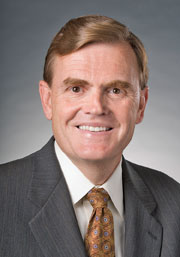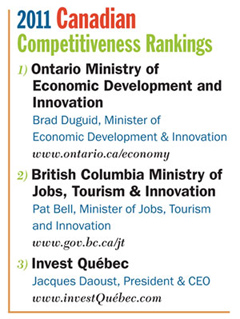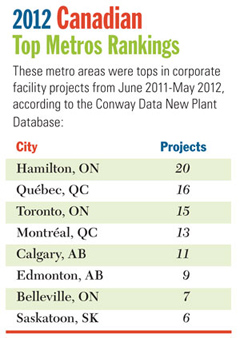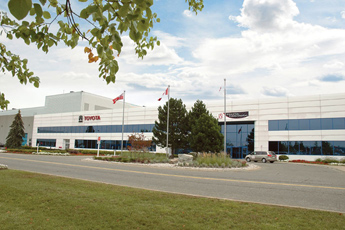In a speech in June to the Economic Club of Canada,
David Abney, COO of UPS, called attention to his company’s investment of US$300 million in its Canadian operations over the past decade, and its recent incursion into Atlantic Canada. But his real purpose was to highlight Canada’s incursions into the rest of the world.
“When it comes to global trade, Canada is leading the way,” he said. “You’re getting it right.”
He called attention to six recent free trade agreements Canada has secured, as well as FTAs it’s still negotiating with India, Japan, the European Union, South Korea, Singapore, and others, many of them emerging markets.

“How can developed nations get on the fast track?” he asked. “Simple. Do what Canada is doing and reach out to embrace the world’s new consumers. Thanks in part to trade, the recovery from the financial crisis in Canada has been stronger and faster than in other G7 countries in terms of employment and output. Canada’s economy has been an anchor of stability in an otherwise turbulent world.”
Flying High
A look at the corporate projects unfolding across the nation reveals both Canadian stability and Canadian outreach.
There’s the natural gas liquefaction terminal being planned by Shell and its partners near Kitimat, B.C. There’s the rare earths processing complex envisioned by Innovation Metals at the Becancour Industrial Park in Québec. And just this summer there were major automotive investments by GM Canada (C$850 million in R&D) and by Toyota ($100 million), both in Ontario.
All of the above have global vision. But the projects sustaining the nation don’t have to be massive in scale. Flying Colours Corp. (FCC) is a global aviation service company specializing in business jet completions, maintenance and refurbishments. From its growing hub at Peterborough Municipal Airport in the Kawartha Lakes region of Ontario (as well as a site in St. Louis, Mo.), it outfits high-caliber aircraft belonging to high-net-worth individuals and corporations from around the world.

Like resource-heavy territories to Canada’s west, Flying Colours is seeing pronounced interest from customers in China, as well as from the rest of Asia, Russia and the Middle East. And it continues to scout Asia for its next operational hub. But its roots are in Peterborough, where the firm began to blossom 36 years ago, and now employs 180.
Sean Gillespie, the company’s executive vice president of sales and marketing, says the firm plans to expand there, just as the airport has recently expanded with a new terminal, longer runway and improved infrastructure. Flying Colours draws support from the Greater Peterborough Area Economic Development Corp., from the province and from a unique training and curriculum partnership with nearby Fleming College.
“I have two airplanes here brought all the way from Hong Kong just to have them refurbished,” said Gillespie in an interview last fall. “That’s a long flight just to be refurbished. But it shows what our people can do.”

Gillespie said employment has risen by 30 percent since the most recent building went up in 2007. “With the next building,” said Gillespie, “I’m confident it will go up at least 50 or 60 percent.”
Confidence like Gillespie’s suffuses the efforts of the Ontario Ministry of Economic Development and Innovation, which this year earns Site Selection’s Canadian Competitiveness Award. The prize is presented each year to the provincial economic development agency that performed the best between June 2011 and May 2012, as tracked by several statistical measurements derived from the magazine’s proprietary New Plant Database, including number of private-sector, corporate facility projects, total investment and jobs created by those projects and number of metro areas with new facilities. The British Columbia Ministry of Jobs, Tourism and Innovation was runner-up this year, marking its debut in the top three since the award was first given seven years ago. Invest Québec earned third place.
In December 2011, the province announced its support of Flying Colours — via the Eastern Ontario Development Fund — in creating 24 new jobs and installing a new special-purpose facility for larger aircraft in Peterborough. More recent projects to receive Ministry support include IBM‘s multifaceted R&D lab creating 145 jobs across sites in Ontario, Markham and Barrie; Cytec‘s hiring of 30 people as it doubles production in Niagara Falls; and Knorr Brake‘s addition of 18 jobs in the university town of Kingston.
Let’s Get Local
Keeping companies competitive is also the primary mission of local and regional economic developers, and characterizes the work of this year’s Top Canadian Economic Development Groups. In addition to available New Plant Database information, we also paid close attention to such subjective but tangible factors as regional partnership, proactive programming and legislation and quality data and Web resources. Here, in alphabetical order by community, are this year’s distinguished groups:
Bruce Graham, President & CEO
www.calgaryeconomicdevelopment.com
Helping make Calgary’s case were facility projects from Canada Safeway, Encana, Fugro Seismic Imaging and GE Canada. Calgary Economic Development has been pulling its weight in the effort to bring skilled workers to the area, participating last fall with Mayor Naheed Nenshi and 40 corporate leaders in the “Calgary. Be Part of the Energy.” campaign to showcase the area as a business center and career destination.
A news release in early 2012 said more than 31,000 jobs “came roaring back” to this metro area of 1.3 million in 2011, representing more than 16 percent of all jobs created in Canada. The comeback has cut unemployment to 4.8 percent from 7.7 percent as recently as May 2010. Calgary is projected to be among the top three Canadian cities in economic strength this year, along with Saskatoon and Edmonton.
In 2011, building permits were issued for 44 projects valued at $10 million or more; overall building permits were valued at $4.5 billion (third highest ever); and industrial land sales totaled $71 million.
Energy, which has attracted $20 billion in Chinese investment alone in Alberta since 2009, is still the leading sector, but has also driven economic diversity in such sectors as financial services and IT. In May, for the first time ever, Calgary made the cut in the Z/Yen Group’s Global Financial Centre Index, which ranked the city 28th in a competitiveness comparison of 77 of the world’s major financial centers.
www.techtriangle.com
The Cambridge-Kitchener-Waterloo nexus of innovation is always a contender, and this year is no exception for the public-private

partnership whose municipal partners also include the townships of North Dumfries, Wellesley, Wilmot and Woolwich. This year has been made especially bright by a pair of expansions from Toyota Motor Manufacturing Canada Inc. (TMMC). In March, the company announced an $80-million, 400-job expansion at its plant in Woodstock. And in July it announced a $100-million, 400-job expansion to increase Lexus production at its Cambridge facility. TMMC currently employs approximately 6,500 people.
Other projects have come from Novocol Pharmaceuticals and solar panel maker Photowatt Ontario. Meanwhile, CTT was part of a group of 15 Canadian city representatives called the Consider Canada Alliance who earlier this year visited Beijing, Chongqing and Guangzhou, China. “Instead of competing against each other to attract new business and investment to our cities, we are all better off working together to bring the investment to Canada,” said CTT CEO John G. Jung.
www.edmonton.com

Recent corporate projects in Edmonton include facility investments by TMK IPSCO, Telus, Samex Canada and Radient Technologies. Programs from EEDC include a new $10-million Edmonton Filmed Entertainment Fund (in partnership with Kilburn Media), part of a strong programmatic and Web focus on tourism and entertainment. It’s one of the target sectors for EEDC, the others being life sciences, energy, advanced education, advanced technologies and a surging financial services industry.
In April 2012, Kent McMullin, director of business development at Edmonton Economic Development Corp. (EEDC), received an Economic Developers of Alberta annual award for his significant contribution to economic development in the Greater Edmonton region. Effective August 1, Brad Ferguson, founder and CEO of Strategy Summit, joined EEDC as president and CEO, replacing Ron Gilbertson, who retired after having served in the post since 2007. A University of Alberta graduate, Ferguson has worked in the private sector, including Procter and Gamble, and KPMG. In addition, he has consulted in strategy development, business planning, and policy work.
www.investinhamilton.ca
From June 1, 2011, through May 2012, 24 new corporate facilities and expansions took place in Hamilton totaling approximately $527 million in new investment, and led by such projects as Maple Leaf Foods’ new $395-million, 670-job meat processing facility, upgrades at ArcelorMittal Dofasco (which employs 5,200) and a $30-million intermodal grain facility from Parrish and Heimbecker at a Hamilton Port Authority pier.
The city’s effective “Hamilton Calling” interview program found that 60 percent of companies in the area hope to invest a total of nearly $273 million over the next three years in their existing Hamilton facilities. Over the past year they’ve created approximately 1,180 jobs. Hamilton’s Small Business Enterprise Centre (SBEC) was also responsible for the creation of an additional 804 jobs, resulting from a total of 41,578 inquiries during the examined period of time.
The city’s Economic Development Division also launched a revamped website, complete with a site selector/property search tool that is mobile device-friendly. The city’s LEEDing the Way Community Improvement Plan and LEED Grant Program was the recipient of the 2011 EDAC/RBC Financial Group Economic Development Achievement of the Year Award. And the Real Estate Investment Network last year ranked Hamilton the top place in Ontario and the third top place in Canada in which to invest- just behind Edmonton and Calgary.
www.ledc.com
Marty Thrasher, chair of the LEDC Board, called 2011 “the most successful year for investment attraction in the LEDC’s history.” Given the organization’s recent track record, that’s saying something. Business attraction efforts in Canada’s 10th largest city in 2011 brought in $311 million and 750 new jobs, while expansion resulted in $71.12 million and 703 new jobs. Among the projects were investments by auto parts firm Arvin Sango and a headquarters/distribution investment by Startech.com.
There was also a 60-job project from geotechnical firm exp. Dr. Oetker Canada in July 2011 announced that it would construct a new frozen pizza production facility, creating 125 direct jobs and anticipated to drive the creation of 300 more jobs in the area. LEDC and provincial officials worked for two years to land the project, which received support from Ontario’s Rural Economic Development Program because it plans to source over 24 million pounds of ingredients per year from Ontario farmers and food processors.
London is expected to post economic growth this year of 3.6 percent, sixth highest in Canada and third highest in Ontario.
www.greatermoncton.org
Enterprise Greater Moncton is the leading community economic development agency for Dieppe, Moncton and Riverview, New Brunswick.

The agency got a boost to its efforts in March when the 2012 KPMG Competitive Alternatives study named Greater Moncton the most competitive city for business in the Canada/U.S. region. Examining 19 industry operations in 14 countries, the study measures the combined impact of 26 significant business cost components that are most likely to vary by location, and compares data on a variety of non-cost competitiveness factors.
Projects to alight in Greater Moncton have included a contact center from ING Direct, a McKesson Canada distribution center and an investment by Maritime Hydraulic Repair.
In February, a report released by the agency concluded that the province should move to implement a digital media incentive program, in order to compete with similar programs offered in other provinces. CEO John Thompson called four digital media companies in his community “precisely the kinds of companies we need to keep here in New Brunswick and Greater Moncton.”
New Brunswick obliged, unveiling its new program on April 17, 2012. (For the ultimate guide to digital media and film incentives in Canada, visit www.pwc.com/ca/bigtable.)
www.initiativespg.com
Known as British Columbia’s northern capital, Prince George is a bustling city located on the traditional territory of the Lheidli T’enneh with a population of approximately 76,000 situated at the crossroads of Highway 97 (north-south) and Highway 16 (east-west), and at the confluence of the Fraser and Nechako Rivers. Belying its small population, it’s fast becoming a major city of the Pacific Rim, and will host the 2015 Canada Winter Games.
The city has welcomed recent projects from utility FortisBC, Pacific BioEnergy and Canfor Pulp. It’s continuing to work with companies eligible for its new Downtown Incentives Program, a partnership among the city, Northern Development Initiative Trust and Initiatives Prince George that offers incentives for new multi-family, mixed-use, commercial and green development, as well as upgrades to existing developments.

On a different scale, Initiatives Prince George has been holding information sessions on BC Hydro’s $7.9-billion Site C Clean Energy Project, a a proposed dam and hydroelectric generating station on the Peace River in Northeast B.C. It will provide up to 1,100 megawatts of capacity, and produce about 5,100 gigawatt-hours of electricity each year.
www.Québecinternational.ca
Québec City has welcomed recent private-sector projects from such companies as Fujitsu Canada (a $19.4-million innovation center), Asentri, Ameresco, and growing biotech firm Medicago. Other projects are under way by Alcoa, Bayer and Ultramar.
The dynamic area of 1.1 million people saw 6,400 jobs created or maintained in the examined period, says Québec International (QI), aided by more than $3.7 billion in capital investment. The metropolitan area’s real GDP rose 2.4 percent in 2011, for the strongest growth (11.9 percent) in the past five years (2006-2011) among Canada’s eight leading metro areas. And even in a difficult economy, the mix of projects included 124 new jobs and $66 million in FDI. QI worked on 105 company files over the past year from abroad, and is currently working a portfolio of 23 active files potentially worth $225 million, with much of the focus coming from the ICT sector. The agency hosted 28 foreign delegations and business missions over the year, including a delegation of 70 from western France.
Among the events and programs QI successfully carried out was the Québec Seeks Solutions event, a collaboration with the Québec Association for Innovation and Technological Development to make innovation and external R&D resources more accessible to small and medium-sized businesses. QI also facilitated formation of the Telehealth/Clinical Mobility Consortium, which includes a number of the area’s most successful life sciences and IT companies.
www.quintedevelopment.com
Among the projects to land in Ontario’s Bay of Quinte region, 75 minutes east of Toronto, are On-Line Support Inc.’s new 200-job customer care and contact center in Belleville, Vantage Foods’ 150-job plant in Belleville, Procter & Gamle’s 100-job expansion in Belleville, SP Data’s contact center and Nestle Canada’s expansion in Trenton, in the Quinte West area, and Canadian Blast Freezer’s $40-million, 150-job distribution operation in Quinte.
The Quinte Economic Development Commission is devoted to growth in the municipalities of Belleville, Brighton and Quinte West. The QEDC maintains a Manufacturing Resource Center that since its inception three years ago has helped companies access over $22 million in government funding support for industry leveraging over $148 million in total investment in the local manufacturing sector. QEDC works closely with Loyalist College in Belleville, which earlier this year joined the Colleges Ontario Network for Industry Innovation (CONII).
Among other relationships, QEDC benefits from close networking and collaboration with the Eastern Ontario Development Fund, the Bay of Quinte Tourist Council and the Quinte Manufacturers Association. The QEDC also has received support from Canada’s Department of Foreign Affairs and International Trade to aid in attracting FDI in the food processing and aerospace sectors.
sreda.com
Saskatoon, a city of 235,000 forecast by many authorities to lead the way in Canadian economic growth in 2012-2013, has seen corporate projects arrive from Maple Leaf Foods, Crestline and Ackands Grainger, among others.
The Saskatoon Regional Economic Development Authority (SREDA) last July announced enhancements to the city’s tax abatement incentive program. The program served 20 clients in 2011, including five new firms. In 2011 SREDA helped seven companies conclude site selections, and two multinationals select research farm sites in the region. SREDA continues to move forward with a regional supply chain analysis expected to lead to action steps this year.
In the first quarter of 2012, Saskatoon had the lowest central business district vacancy rate in the nation, at 1.91 percent. During the quarter the city issued 350 new business licenses and saw its employment market grow by 3,500.
Last September, the University of Saskatchewan, in partnership with the Saskatoon Public School Division, was approved to host a Confucius Institute on campus in order to promote awareness of Chinese culture, language and history to the university community and city of Saskatoon. It’s the 13th such institute to land in Canada. Approximately 40 percent of the university’s international undergraduates are Chinese.
